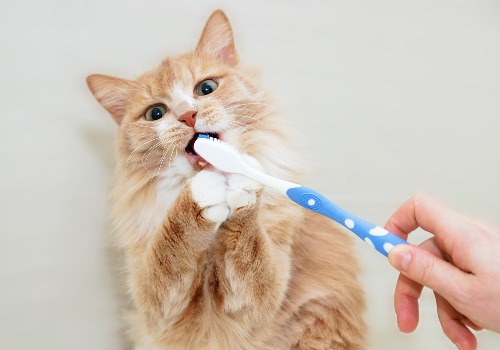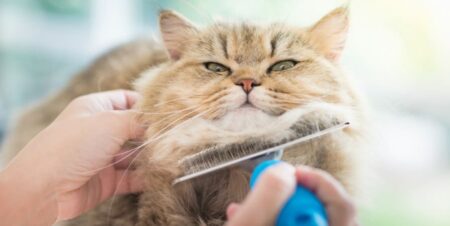Cats are the perfect pets, but they can also be a little bit tricky. One of the most common questions cat owners have concerns their teeth. If you think about it, there really isn’t anything more important than taking care of your pet’s health and well-being.
This article will go over some tips on how to brush your cat’s teeth by using a toothbrush and some food-grade dental gel for cats (or just water mixed with a small amount of baking soda).
Why Should You Brush Your Cat’s Teeth?
We all know the importance of brushing our own teeth, but brushing our cat’s teeth is just as important. By brushing your cat’s teeth regularly, it will help prevent tartar buildup and prevent bad breath of your beloved pet. Brushing your cat’s teeth will also help with any health problems cats might have with their mouth.
Most cats that are three years old and above suffer from periodontal disease. Periodontal disease is the result of infections (and inflammation) of the gums and bones that hold teeth in place. Many cats have bad breath because they build plaque and tartar around their mouth. The bacteria from this buildup can lead to periodontal disease.
How Often Should You Brush Your Cat’s Teeth?

Ideally, you should brush your cat’s teeth at least once per week — and for about 3 minutes on each side (it will take less than 10 minutes total). If you have younger cats, consider giving them a little more time because smaller cats need extra care and attention. Teaching your cat(s) to accept brushing is a good idea. You can use treats and play with them to help get them used to the idea.
How Do You Brush Your Cat’s Teeth?
Beware of fragile cats! It might take patience and a gentle touch, but you can often remove tartar buildup with your fingers.
To begin, rub your finger against the gums on both sides of the teeth until you feel the tooth beginning to loosen. Note that it will not be easy for cats to bite down on your hand or finger.
Take a toothbrush with soft bristles designed for pets and some food-grade dental gel for cats (which is safe to ingest). Use a circular motion to brush the teeth and gums. If your cat is cooperative, you can use a finger toothbrush.
Your veterinarian or pet store will carry the finger toothbrushes. You can also mix water with baking soda, but be sure not to leave it in water too long as it could cause bad breath in your favorite furry friend.
Alternatively:
- Select a quiet time, sit on the floor with your cat, and let your cat come to you.
- Allow several minutes for your cat to approach you. If necessary, give a few treats before applying the toothbrush.
- Take a cotton swab and put it in water drained from a fish can. The water has no dental benefits, but putting anything in your mouth will encourage your cat to open its mouth.
- Place the cat’s head at 45 degrees angle and brush the upper teeth from the farthest corner to the middle. Repeat from the top of one tooth to the bottom of another tooth.
- Use the cotton swab or applicator to rub along the cat’s gums, flossing the teeth.
- Place the cat at a 90-degree angle for the lower teeth, allowing the head to rest comfortably in your lap. The cat should be facing your knees.
- Brush from one corner of the mouth to another and then from front to back along with each tooth. Repeat this process from both ends of each tooth and between each tooth.
- Once the cat gets used to the swab, you can introduce a toothbrush for the cat’s teeth.
- You should take your time and do not rush. For a hard-to-reach tooth, you may need to get some help! With patience, your cat will accept being brushed and allow you to get down close to them. They will trust you more as well!
Cats need a good brushing once per week. If you have multiple cats, you can brush each one individually and then as a group.
What Type of Brush Should You Use to Brush Your Cat’s Teeth?
[amazon bestseller=”Soft Cat Toothbrush”]
Specially designed brushes for cats are available at most pet stores. These brushes have soft bristles and rounded ends. These brushes are small and slender, which are better for cats than regular toothbrushes. You can use the rounded end to brush between teeth, and the bristles will massage the gums simultaneously. A good quality brush should last 3-4 months (or more). You can consult your veterinarian to see which brush he or she feels is best to use. Irrespective of the brush you use for your cat, remember that about 3 minutes of brushing is all you need to do for each side.
Is It Okay to Use Human Toothpaste?
Many kinds of toothpaste are available for humans, which are generally free of fluoride. This is because certain kinds of toothpaste can cause teeth staining if they contain fluoride, a known chemical that can stain teeth. This can also be harmful to your cat as well, but you should use professional toothpaste designed just for cats.
Is It Safe to Give Cats Mint Toothpaste?
Mint-flavored kinds of toothpaste are not recommended for cats. Cats have very sensitive stomachs and usually cannot handle mint-flavored toothpaste. If you will use any toothpaste on your cat, avoid mint flavors. It’s best to ask your veterinarian which type of toothpaste will be most suitable for your cat.
Recommended Toothpaste for Cats
[amazon bestseller=”cat toothpaste”]
- Professional toothpaste (made just for cats)
- The inexpensive cat toothbrush and toothpaste kit — Petrodex Dental Kit for Cats (with malt flavor toothpaste) is a highly recommended one on Amazon.
Good toothpaste is veterinarian-approved, as they are made to help clean your pet’s teeth and gums.
What Else Can You Do to Keep Your Cat’s Teeth and Gums Healthy?
Feed your cat high-quality cat food. This is especially important for cats older than 3 years of age. The best brands have specific dental diets that contain extra taurine. Taurine is an essential amino acid, and it is extremely important for your cat’s overall health, including the health of its teeth.
You can also feed them some canned food. Be sure it is canned beef or chicken instead of canned fish, which is harder on their teeth. You can also give them some treats that are healthy for them. For instance, you can give them pieces of cooked chicken or beef, but be very careful about giving treats that aren’t good for their teeth.
If your cat is reluctant to have its teeth brushed, you can distract it with laser light. Use the laser as a reward because your cat will eventually associate having its teeth brushed with something pleasant.
Your cat will not need any veterinary care if you follow the above recommendations. However, your veterinarian is the best source of information to tell you about the specific care your cat needs for its teeth and gums.
There are many dental problems in cats, but if you provide proper oral hygiene and a balanced diet, they can live long, healthy lives with good teeth and gums.
Summary
Cats do not have many teeth as humans do, but they have a few important teeth for their health. They have a set of primary teeth: four incisors and one canine tooth. They also have an additional set of canines and premolars, which help them survive in the wild. Good oral hygiene is essential for healthy cats because soft or sensitive teeth will be painful for them and affect their appetite. The best way to help keep your cat’s teeth healthy is by brushing them at least once a week, checking them regularly, and providing a good diet. Also, you should take them to the vet for regular dental check-ups.
How to Brush Your Cat’s Teeth (Video)
"In ancient times cats were worshipped as gods; they have not forgotten this."
-- Terry Pratchett





